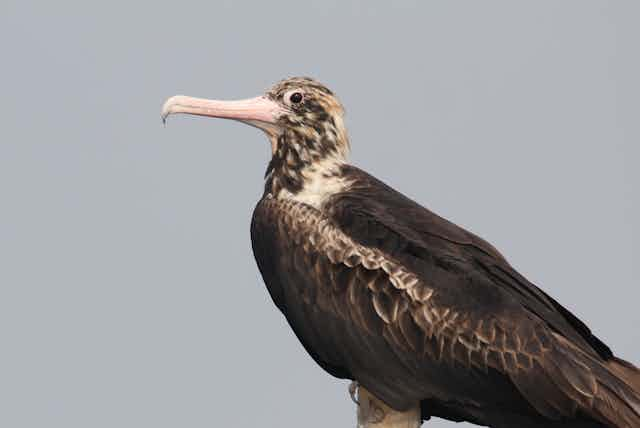The Christmas Island Frigatebird is a spectacular large seabird. It is one of only five frigatebird species, all with glossy black plumage, long narrow wings, buoyant and acrobatic flight, and long bill with terminal hook.
Three species (the Magnificent, Great and Lesser Frigatebirds) are widespread in tropical oceans. In an unusual biogeographic contrast the Christmas Island and the Ascension Island Frigatebirds each occur on only one island, with the additional oddity that the Christmas Island Frigatebird shares the island with Great and Lesser Frigatebirds.
Christmas Island is home to many species that are found nowhere else, a consequence of isolation for millions of years, and of the late date of its human settlement (the 1880s).

Frigatebirds are perhaps best known for kleptoparasitism, the unnerving practice of terrorising other seabirds to force them to regurgitate their day’s catch of fish. This piratical tendency, their large size, dark profile and masterful flight, earned them the respectful name of “Man-o-War Birds” amongst early sailors.
Another frigatebird feature is the preposterous bright red gular (throat) pouch ornamenting the males. In the breeding season, groups of males display from would-be nest sites (in tree canopies) by inflating this appendage like a grapefruit-sized balloon, tipping their heads back and drumming on it with their bill to increase their attractiveness to over-flying females.
Status
The Christmas Island Frigatebird has many traits that render species threatened. It breeds on only one island, it reproduces slowly (with females breeding every second year and the single young requiring at least 15 months of parental care), and breeding success is relatively low. Its population size is small and has been decreasing for many decades.

It is listed as Critically Endangered under the Environment Protection and Biodiversity Conservation Act and internationally (the IUCN Red List).
Threats
The first visit to Christmas Island, by William Dampier in 1688, set the tone, with collections of “as many boobies and man-of-war birds as sufficed all the ship’s company when they were boiled.” Early settlers followed the precedent.
Numbers declined rapidly, from a naturally small base of 6200 breeding pairs in the 1890s to about 3300 in the 1940s, despite gradual regulation of the take. (Note that the population is tricky to estimate, as the two-year breeding cycle means that some individuals are not present in any year.)
From 1980, much of the island has been protected as National Park, and hunting prohibited. But the frigatebird has continued to decline, to 2300 (annual) breeding pairs in 1970, and 1200 breeding pairs in 2005. Counts indicate continuing decline over the period 2008 to 2011.
The rich legacy of Christmas Island’s endemic species has eroded rapidly since it was settled. About 25% of the island’s rainforest extent has been cleared for phosphate mining. Plumes of phosphate dust formerly coated the trees in one of the frigatebird’s few breeding colonies, and this pollution probably caused the loss of that colony.
Settlement has brought very many unwanted plants and animals. Weedy creepers now throttle nesting trees and entangle birds. Supercolonies of aggressive Yellow Crazy Ants now swarm in the tree canopies. Cats and rats have caused the decline of other seabirds and hence the opportunities for kleptoparasitism.
But this species also has broader problems. When not breeding, it disperses widely in the seas beyond Christmas Island northward to near the Philippines. In these areas, it is exposed to hunting, entanglement in fishing material, depletion of fish stocks, and habitat loss on islands used as transit stops.

Strategy
The survival of the Christmas Island Frigatebird depends upon reversing habitat degradation in its restricted breeding site. But it is also susceptible in its dispersal across what are now political boundaries. Like many other wide-ranging species, its conservation requires international cooperation.
A Recovery Plan was developed in 2004, but has been little implemented, and the ongoing decline attests to its failure. From the recovery plan, there has been some research, mostly by David James and Janos Hennicke, and some recent funding support from Australian Geographic.
A regional recovery plan for Christmas Island biodiversity generally is being developed, and, if adequately resourced, may provide a more strategic and effective approach.
Conclusion
The Christmas Island Frigatebird epitomises much that is most wonderful and challenging about biodiversity. It is magnificently adapted to a particular robust ecological role, but remarkably fragile in other traits. It illustrates the role of islands as the engine-room of evolution, but of the frailty of such sites. It shows that we have the opportunity to redress cavalier and irresponsible treatment of nature by our forbears. And perhaps most importantly, it is an example of the need to complement local-scale conservation strategies with collaboration beyond national boundaries.
The Conversation is running a series on Australian endangered species. See it here

